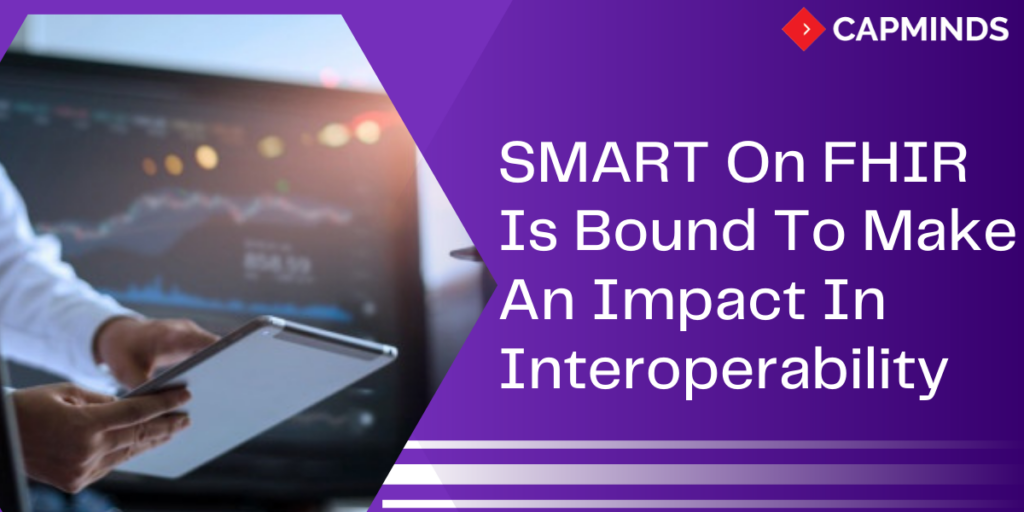SMART On FHIR Is Bound To Make An Impact In Interoperability
As the growing healthcare industry continues to make a drastic shift from fee based care to value based care, data interoperability serves as a key concern for providers to ultimately drive better health outcomes. The on demand information exchange speaks about the two major concepts SMART and FHIR. Here is all about SMART on FHIR.
What is SMART?
SMART provides a standard for how EHR systems and their applications authenticate and integrate. By standardizing these processes, health care providers can utilize more apps, and developers can write apps for a wider audience.
The original goal of SMART was to enable any developer to create a healthcare application that would work at any healthcare organization, regardless of EHR. SMART moved away from developing the standard and instead focused on formalizing the process for interacting with FHIR interfaces, outlining how the apps will be “launched” from the EHR, and standardizing the security protocols used by third-parties to exchange data with healthcare organization’s EHR systems.
SMART handles the authorization of a user accessing a patient’s data and maintains an open source library for developers to use. It also provides and maintains free API “sandbox” servers that developers can use for testing their application. The sandbox simulates a healthcare provider launching the application with one of many fake contexts with generated patient data.
What is FHIR?
FHIR (Fast Healthcare Interoperability Resource) is a technology that is beginning to provide some consistency to the data that SMART-compliant EHR systems access. FHIR provides an API and a set of data models for structuring and accessing medical data. In recent days, the major U.S EHR vendors are increasingly started adopting the FHIR standard because it allows them to meet ONC certification criteria related to application programming interfaces:
RELATED :
ROLE OF FHIR IN INTEROPERABILITY
WHAT IS FHIR? WHY HOSPITALS SHOULD CARE?
FHIR: A NEW PATH TOWARDS HEALTHCARE INTEROPERABILITY
SMART on FHIR
The SMART project, Substitutable Medical Apps & Reusable Technology, was borne from an essay published in New England Journal of Medicine in 2009 by Isaac Kohane, MD, PhD, co-director of the Center for Biomedical Informatics at Boston-based Harvard Medical School and director of Boston Children’s Hospital Informatics Program, and Kenneth Mandl, MD, chair of biomedical informatics and population health at Boston Children’s Hospital.
The key focus of SMART is to develop a SMART platform architecture to achieve two major goals: develop a user interface to allow substitutability for medical apps based on shared basic components and create a set of services to enable efficient data capture, storage, retrieval and analytics.
FHIR is the latest standard to be developed under the Health Level Seven HL7 organization. FHIR allows clinician applications to access patient datasuch as aggregated health records, risk assessments, precision medicine, and patient education materials IN A standards-based methodology outside of the EHR. FHIR solutions are built from modular components in such a way that any EHR system can read extensions in app coding for seamless implementations.
SMART is the application side while FHIR is all about the data. Together, Smart on FHIR creates a framework to build healthcare applications that don’t rely on one specific vendor—so it can run across any healthcare system with a seamless user experience for the clinicians, in a secure manner, without having to write custom, non-standard applications.
Today, SMART & FHIR represent an open, standardized, and practical means of exchanging data among EHRs, health system sites, and data sources. The SMART team maintains a sandbox and app gallery and continues to innovate with projects like CDS Hooks, Flat FHIR, and SMART Markers.
The Reason to Focus On FHIR
For clinicians to realize the full value of an EHR, it’s important that all aspects of patient care are integrated into the system. While there are a growing number of technologies that gather and store this information, the challenge is to make these different sources of data—from hospitals, clinicians, health plans, patient portals, databases and, increasingly, patients—effectively talk to one another.
FHIR is one way to establish data source access standardization. FHIR saves time on the often-burdensome steps to mine big data, access patient records (providing a comprehensive picture of the patient’s health record), and make recommendations for more intelligent patient education that is always up-to-date and in line with current best practice standards. FHIR enables healthcare institutions to maximize their EHR investment by streamlining internal customization projects and drawing on a library of innovative apps.
RELATED: DON’T MISS THIS: 9 PROVEN IMPLEMENTATION BENEFITS OF FHIR
Final Thoughts
SMART is also very committed to producing “how-to documentation” designed to help developers get up to speed on what FHIR makes available and how to build alongside SMART for future roll outs to live healthcare settings. SMART on FHIR is becoming a requirement for organizations nationwide, providing a compelling reason to roll out a SMART on FHIR capability.




